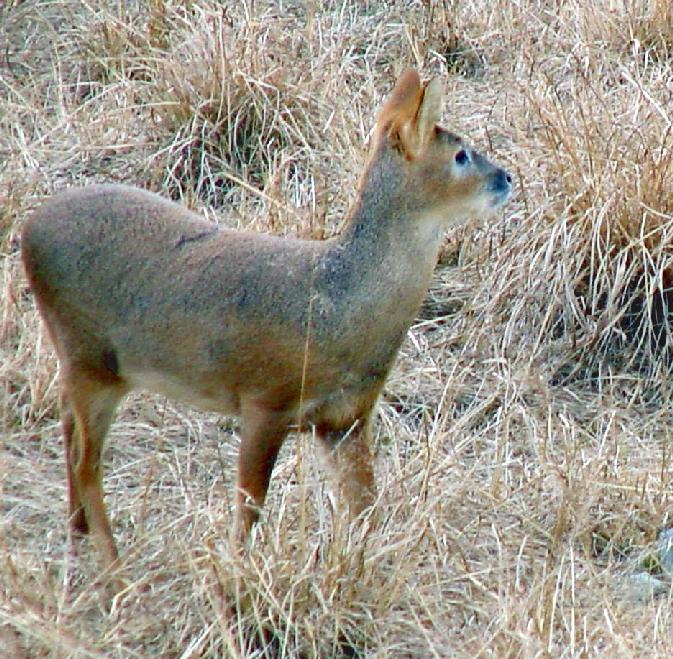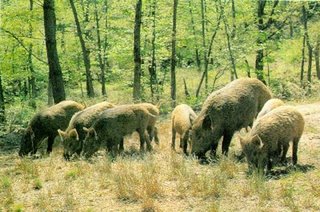Function
The function of a breed is an extremely important quality. When dogs are breed under how well it performs this function, it determines how the breed should look like and how it should act like.
With the Jindo, the Jindo's function was determined not so much by man, but was determined by its environment. "Nature-made" is a common description. This is an important distinction from many man-made breeds and requires a shift in thinking.
What is required is keen observation of many Jindo dogs, to determine what activities and abilties are common to all Jindos, and how it relates to the mental character of the dogs.
Hunting
The Jindo has the well-deserved reputation of being as an excellent hunter who has the natural, untrained instinct to retrieve their prey to their masters. As youngsters, they are observed honing their patience and skills on mice, rats, and birds, and then as they mature and have the opportunity, they move on to hunt small animals such as rabbits and raccoon dogs. Unless they are reprimanded by their owners or disappointed by their owners' reactions, they bring these small prizes back to their masters without being taught.
The Jindo often traveled long distances or several days on the island, and so a natural homing ability developed in them so they could still find their way home to their master either with or without a prize in mouth. This homing ability was tested in modern times even when the Jindos were removed far from the island.
Within the island, the Jindo's larger quarry consists of deer and wild boar.

Korean Water Deer (GoRaNee)
photo by Jinsuk Kim |
The wild deer found on the island is the Korean Water Deer which is only 22 inches high at the shoulder. Though the deer is faster than any Jindo on flat terrain, a pack of Jindos can work together to catch the deer. Some dogs power their way directly at the deer, driving the deer towards their hunting partners that have taken up flanking positions. The pack may also work together to drive the deer downhill, knowing that the deer must slow down when going downhill. There was a need for intelligence and problem-solving during these chase hunts.
A single Jindo can also catch a deer by itself by taking hidden positions near a trail and waiting hours for a deer to pass through. There was a need for alertness and patience during these ambush hunts.

wild boar |
The wild boars that exist on the island usually do not reach the size of the wild boars that reside in the mountains of northern Korea, but they are still quite formidable with their sharp tusks and thick skin. A smaller boar may be tackled by a small pack of 3-4 Jindos working on their own. A larger boar would cause the Jindo to assess whether the fight is worthwhile and whether their owner is nearby to provide sufficient motivation. If so, the Jindo harries and attacks from the rear rather than the head of the boar.
No big predator lives on Jindo island, however, the Jindo dog has a reputation for being extremely brave and courageous in facing these animals. This reputation was based on how, a long time ago, dogs were taken from the island and a few lines were used by nobles and hunters. They were used to hunt big game animals located on the Korean pennisula, and the quarry was finished off by arrow or spear by the human hunter. The types of animals that were encountered in Korea were leopards (Amur leopards), tigers, wolves, bears, and wild boars. These animals were killing villagers as late as 1928 according to a report produced by the Japanese Police Bureau in Korea during the Japanese occupation.
The Jindo obtained the reputation as being a tiger-killer, but it is unclear how many Jindos were needed to kill a tiger. It could be three, as romantic oral tradition has indicated, or it may be 13 as passed on by one oldtimer. Regardless, a 40 lb dog facing a 500-900 lb tiger, even alongside 20 packmates, would need extreme courage and loyalty to stay with his human and not run away.
Guarding
Because the Jindo evolved loose on the island, they had to develop territories amongst each other. Their view of their territory loosely overlapped with that of their human who raised them or feed them some food.
The Jindo had to balance between decisively defending their territory versus not wasting extraneous energy on unneeded battles. They also had to learn not to provoke their humans by attacking the wrong people or wrong animals such as domestic livestock.
Thus the Jindo became a discriminating guardian with a long memory. They learned not to give alarm at normal routines in their neighborhood. They learned to recognize and accept regulars, but still show instant aggression against intruding strangers until their owners indicate otherwise. They are willing to bite when their owner is physically attacked and will show aggression against other dogs that may infringe on their terrirtory and resources.
Roaming/Sense of Direction
Surviving
There are several other activities that are common in all Jindos.
Cleanliness. The Jindo will often eliminate far from his living area. This instinct is strong even in young puppies.
Caution against Easy Food. The Jindo will often reject food that has been given by a stranger. Some Jindos will also reject eating dead animals that they encounter but they themselves have not caught.
Sensitive towards Rank. This describes the dog's interaction with another dog or within a pack, but it also describes the dog's interaction with people. In a Korean household, rank and hierarchy is practice in verbal language, body language, and even meals. Many Jindos pick up on this and instinctively know where their own place is in the household -the bottom. In a different household where this rank and hierarchy is not so prominant, issues may occur when the dog is confused about where they exist on the hierarchy.


